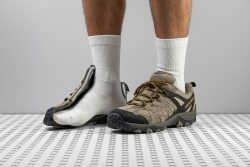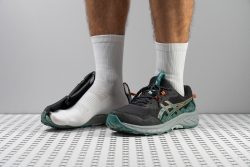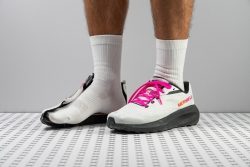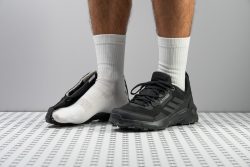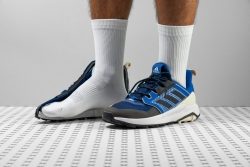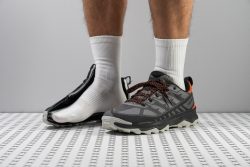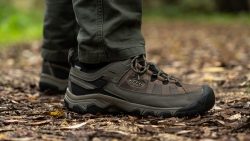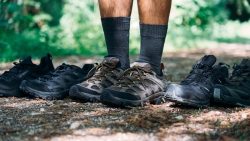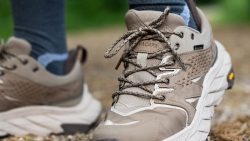6 Best Cheap Hiking Shoes in 2025
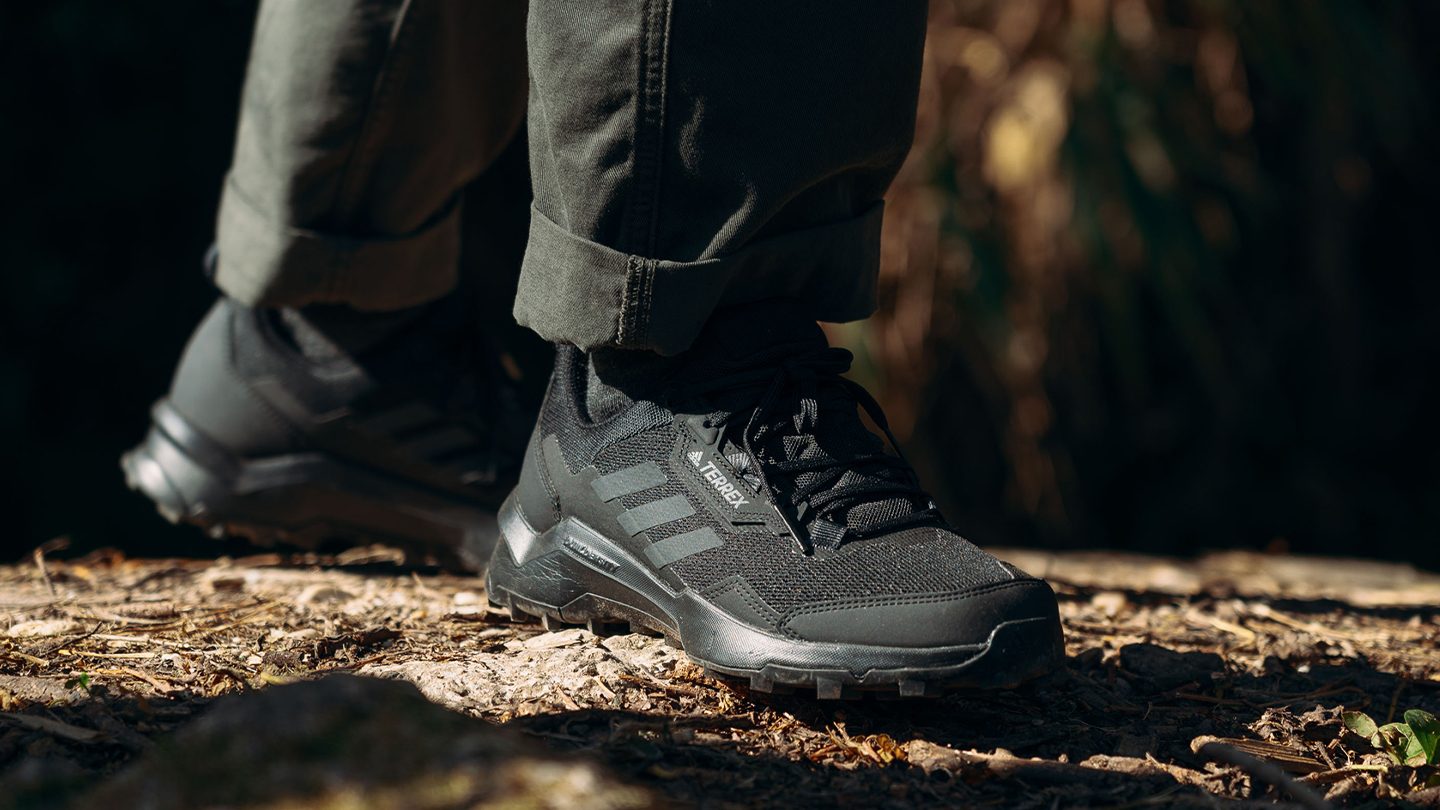
We buy shoes ourselves. We earn commissions when you buy through us, at no extra cost. Why trust us
You don’t have to break the bank to buy a new pair of quality hiking shoes. For this guide, we’ve rounded up and personally evaluated tons of really good deals under the $110 range.
From the popular Adidas Terrex models to the highly-rated Merrell Moab series, these kicks are known for their extraordinary tenacity, plushness with some more extra features, and, yes, affordability. We've also got plenty of pairs in our cheap hiking shoe collection, ranging from leather hikers and waterproof kicks to winter hiking shoes.
How we test cheap hiking shoes
To create this comprehensive guide, we hiked in each pair of cheap hiking shoes, covering different terrains. We also checked the materials and technologies in our RunRepeat lab, where we measured 20+ features of hiking shoes.
Our selection method includes doing the following:
- They may be cheap, but we still buy these hiking shoes with our own money! This ensures the independence and 100% impartiality of our reviews.
- We take the shoes on a series of backpacking trips and day hikes to get a first-hand experience of their overall performance. We highlight the shoes’ fit, shock absorption, traction, support, heel protection, and many more. We also see how the shoes perform during inclement weather conditions and in tougher terrains.
- We test the shoes in our lab using different tools like durometers, calipers, a Dremel, a smoke machine, etc. We even reach a point where we cut the shoes into pieces just to reveal all the elements that are usually unseen by wearers.
Best cheap hiking shoes overall
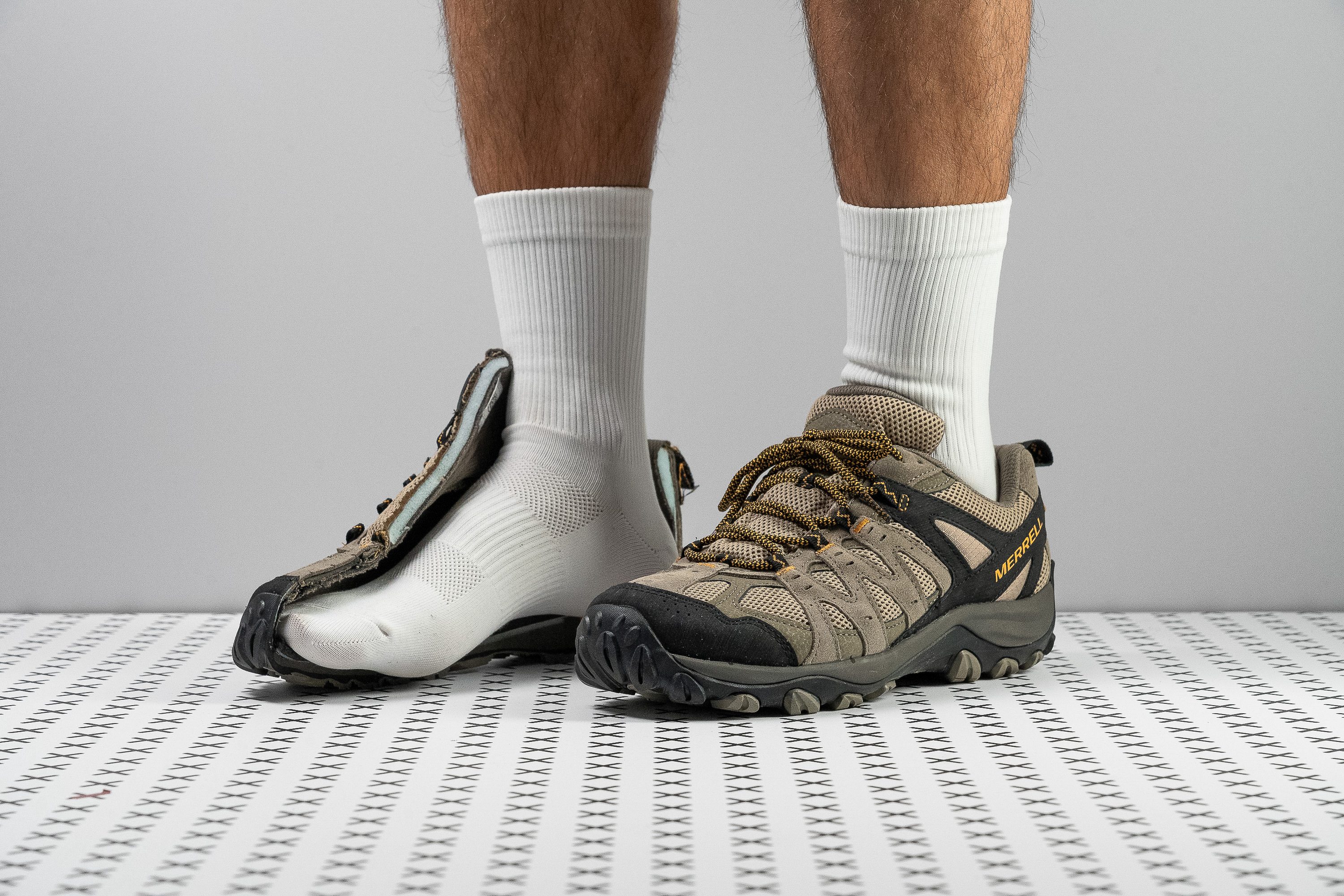












































What makes it the best?
It’s hard not to love the Merrell Accentor 3 because of the comfort and surefootedness we experienced. Our lab results validate that it has a supportive yet flexible midsole, with a roomy toebox that welcomes wide feet with ease. For only $100 vs. the $142 average hiking shoe in the lab, it doesn’t compromise the essentials, making it our best cheap hiking shoe overall.
The supportive nylon shank in the midsole provides a sturdy landing platform, helping this shoe to feel stable while trekking. Surprisingly, it exceeded our expectations in our lab flexibility test. Pushing it to reach 30 degrees required only 14.0N, making the Accentor 3 14.8% more flexible than average! It keeps us relaxed while still offering support.
The toebox is non-tapered, and we created a gel mold to confirm its generous interior further. Measuring 74.6 mm, it can comfortably accommodate those with swollen or square-shaped feet compared to the 72.5 mm average. Moreover, it has lots of vertical clearance at 32.3 mm!
On warmer days, our feet get hot and sweaty, which could lead to blisters. Therefore, we don’t recommend the Merrell Accentor 3 for summer hiking. It scored the lowest 1/5 for breathability in our smoke test.
Pros
- Stellar support
- Amazingly comfortable
- Performs well in the cold
- Can gobble up miles
- Versatile grip for moderate terrain
- Alleviates foot pain
- Fits like a glove
- Roomy and durable toebox
- Very easy to put on
- Budget-friendly
- Sustainably made
Cons
- Lackluster breathability
- Could be lighter
- Unruly laces
Cheap hiking shoes with the best durability
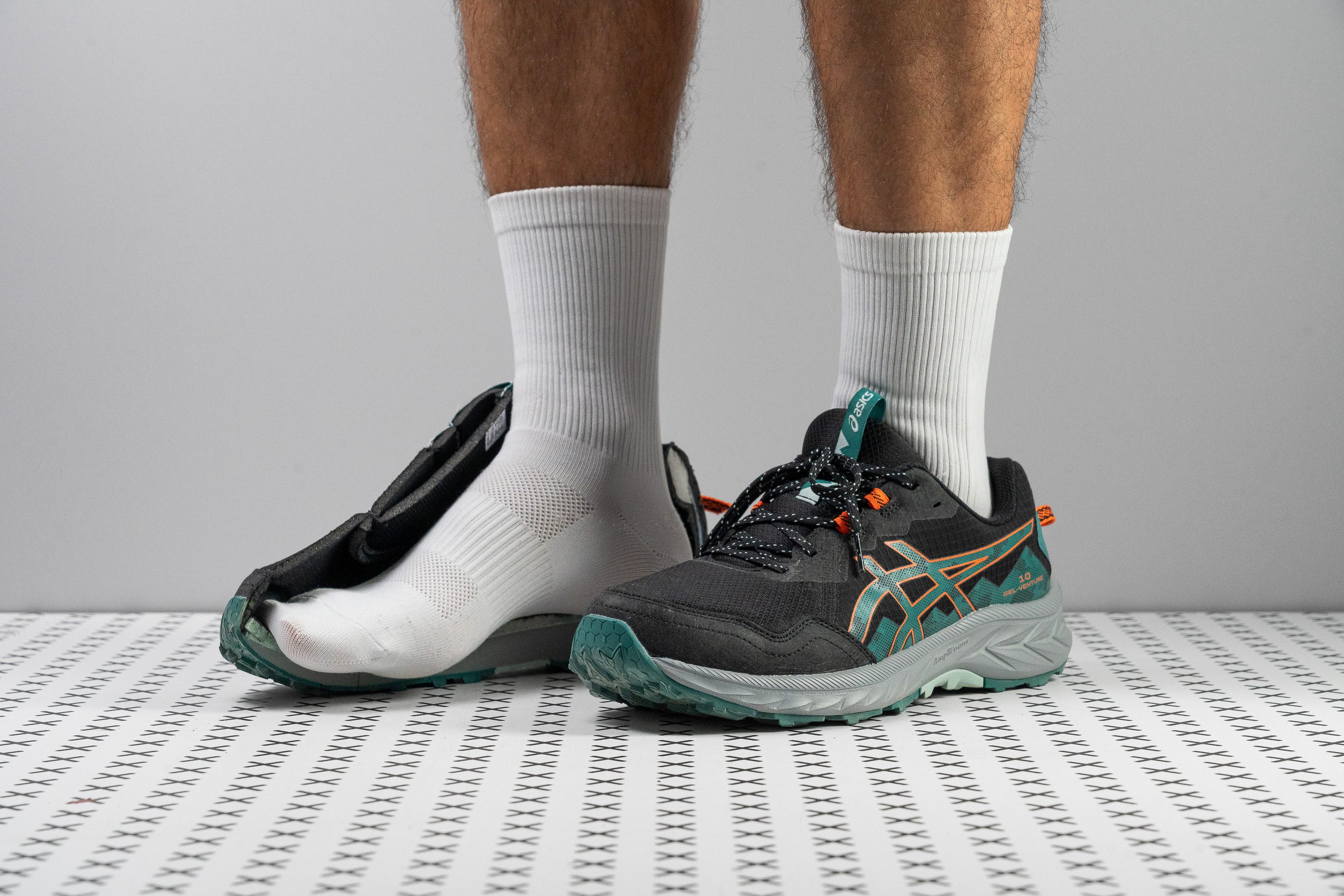











































What makes it the best?
We didn’t expect the ASICS Gel Venture 10 to perform as well as it did in the lab, considering it stays way under the hundred bucks range. For only $80, it offers all-around wear resistance, ensuring the shoe’s long lifespan. Moreover, its flexible and fuss-free personality enhances comfort in our treks. Overall, it’s our best durable, cheap hiking shoe.
The GV10 smashes our Dremel tests from top to bottom, displaying impressive sturdiness. The toebox had insignificant damage, scoring 4/5, while the heel padding remained intact and received the maximum 5/5 score. Meanwhile, the outsole only sustained a small 0.6 mm dent compared to the 0.9 mm average, cementing its protective and long-lasting nature.
It feels easy on the feet during our relaxed strolls as the midsole flows with our movement. Our bend test verifies it’s 13.7% more pliable than average. Moreover, its weightless feel is enhanced by its minimal 11.4 oz (322g) build. For a hiking shoe, that’s impressively light since the average in our lab weighs 15.3% more.
However, the platform offers limited impact protection with its below-average 105 SA rating. Those seeking a plush sensation underfoot and more joint protection should go for shock-absorbing pairs.
Pros
- Fantastic durability
- Amazing value
- Ideal for beginners
- Softer Amplifoam midsole
- Versatile for trail, travel, casual wear...
- Improved upper
- Plush tongue with pressure-free lacing
- Trail-inspired details at budget price
Cons
- Only for narrow feet
- Heavy
- Low shock absorption and energy return
Cheap hiking shoes with the best shock absorption
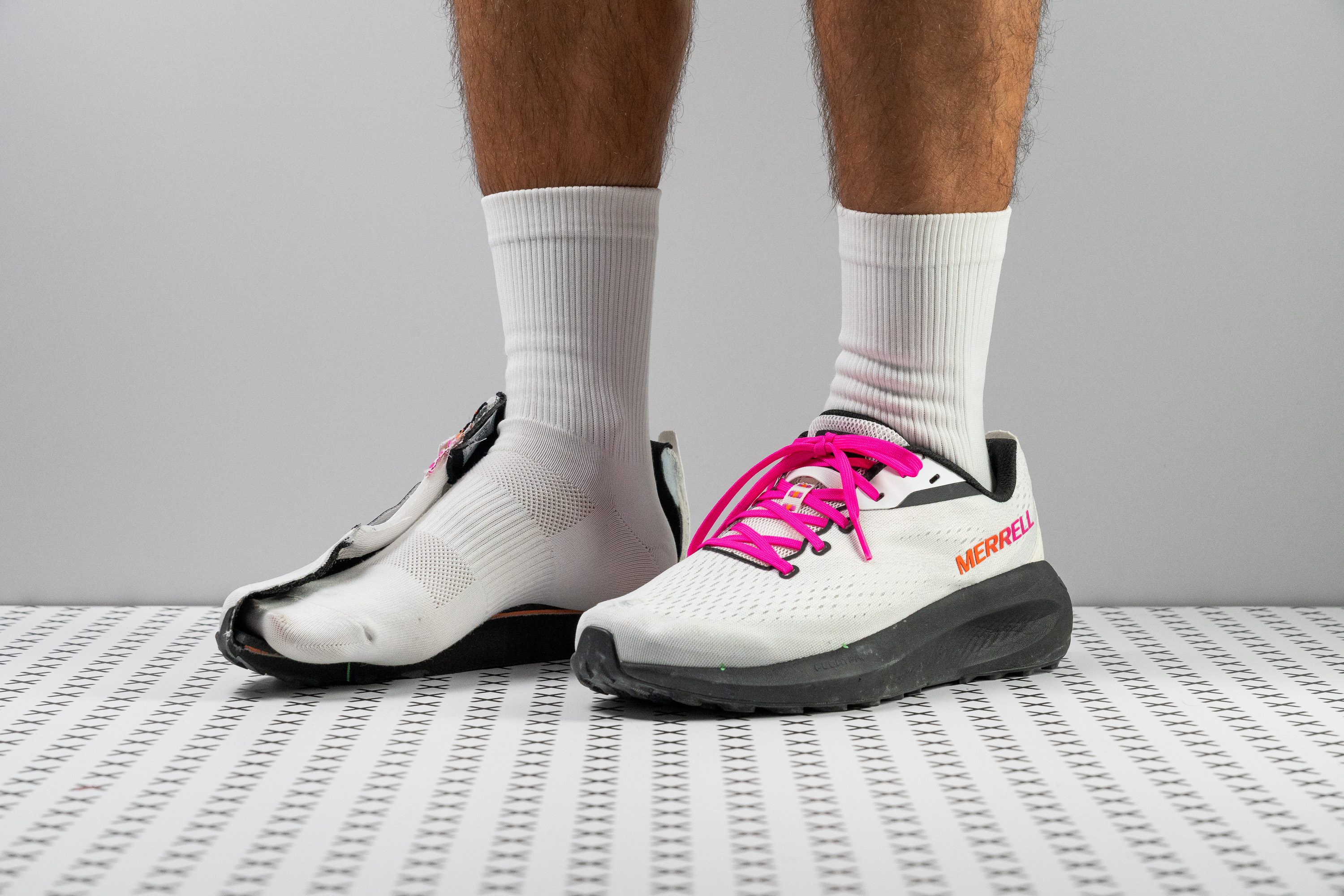











































What makes it the best?
For its accessible $100 price, the Merrell Morphlite completely captured our hearts and our feet with its 5-star comfort. From its premium shock absorption to its flexibility, all in a lightweight package, lab tests reveal that Morphlite feels good to be in all day. It's our best shock-absorbing, cheap hiking shoe, considering the average in the lab costs $142.
From the moment we slipped on the Morphlite, it was clear that it's incredibly comfortable. While it’s not a maximalist in terms of height, with only 32.2/21.3 mm of foam, its plush sensation comes from its high impact protection. Scoring 125 SA in the heel, it’s able to reduce the stress of each touchdown on our muscles and joints better than average.
Because it doesn’t have to be so thick, Morphlite actually shows exceptional flexibility. In our bend test, it’s 30.1% more pliable than average, which means it takes less effort to move our feet.
Moreover, its weightless build enhances its comfort and versatility. At only 8.4 oz (237g) on our scales, Morphlite is 18.0% lighter than the average hiking shoe.
Unfortunately, the outsole wears faster than average, as seen in the deep 1.4 mm damage our Dremel created. It also has lots of exposed foam, making the shoe vulnerable to rough surfaces and sharp rocks. If this is a dealbreaker, we recommend looking for a sturdier hiking shoe.
Pros
- Excellent price point
- Versatile across multiple terrains
- Feather-light build
- Eco-conscious recycled materials
- Improved fit vs. previous Merrells
- Works fantastic for heel strikers
- Good arch support
- Well-designed tongue
Cons
- Sparse outsole coverage
- Major durability concerns
- Drop differs too much from stated
- Not for wide feet
Cheap hiking shoes with the best stability
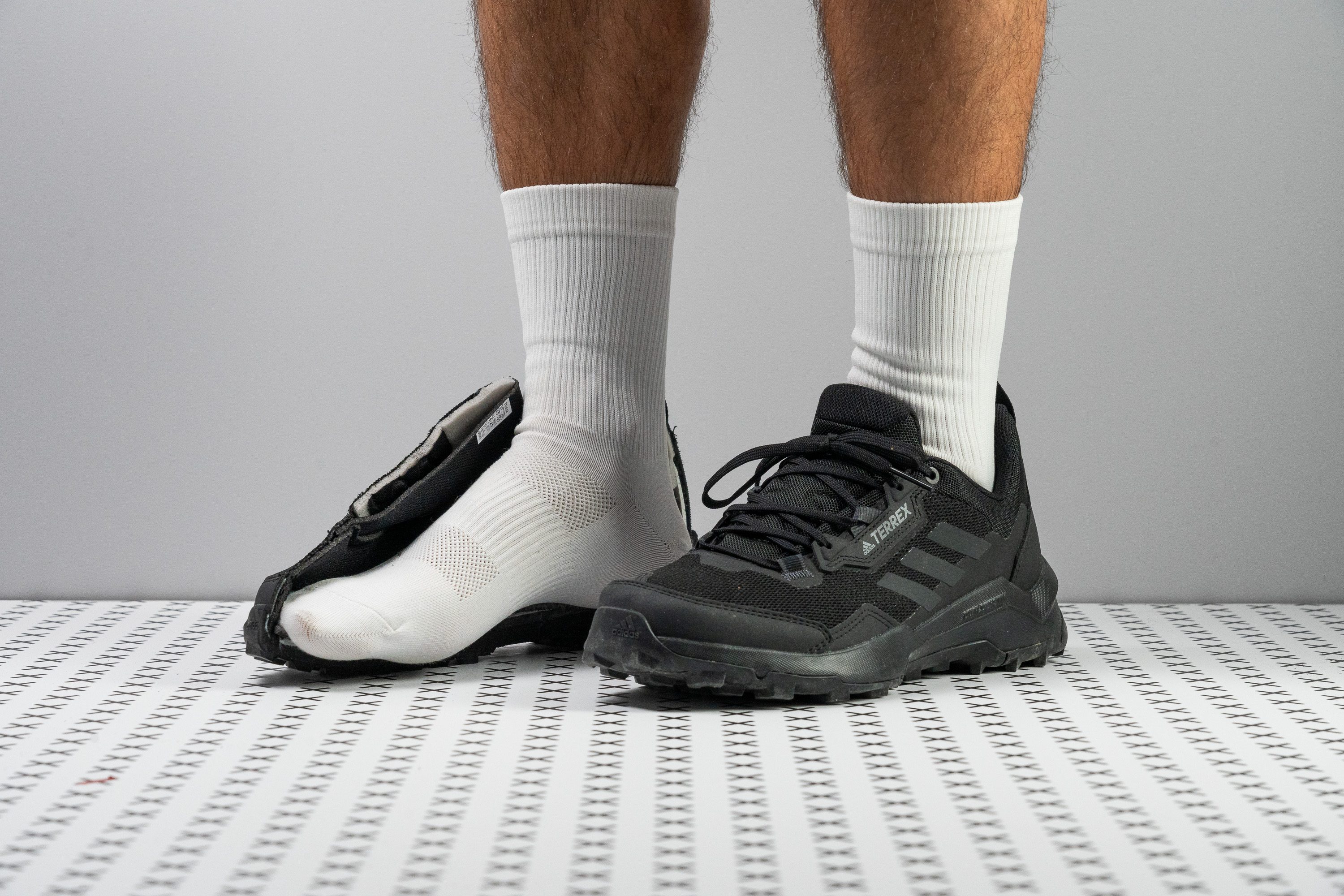






































What makes it the best?
After putting a range of cheap hiking shoes to the test, the Adidas Terrex AX4 is the obvious choice of the most stable, cheap hiking shoe. Its wide platform keeps us steady on the trail, while its firm cushioning protects us from trail hazards. At just $90, it's even $22 cheaper than the average summer hiking shoes, making it an excellent value for money. What's not to like?!
The ample midsole of the Terrex AX4 excels at its job of preventing ankle rolls. Measuring 111.5 mm at the forefoot and 87.9 mm at the heel, this shoe is around the average width for hiking shoes. The stiff heel counter also plays its part by holding our heels securely while hiking steep hills and over rough ground. In the lab, we awarded it the stiffest rating of 5/5. All in all, this feels like a stable, trustworthy shoe!
The AX4 compensates for its slightly lower stack height by upping the ante in the midsole. We pressed a durometer to the midsole in the lab and it registered 39 HA, 27% firmer than average. It feels firm and protective on our feet, and we feel supported and safe while hiking.
We can safely say the Adidas Terrex AX4 is not a flexible shoe for winter hiking. After simulating winter conditions in the ice box for 20 minutes, we noted a 66% increase in stiffness compared to room temperature! Hikers looking for a more winter-ready shoe can take a look at the Adidas Terrex Swift R3 GTX.
Pros
- Excellent value for money
- Feels like a trail running shoe
- Breathable
- Water-repellent
- Excellent grip
- Durable for the price
- Stable platform
- Contains recycled materials
Cons
- Lacks toe protection
- Flimsy insole
- Aggressively tapered toebox
Cheap hiking shoes with the best breathability
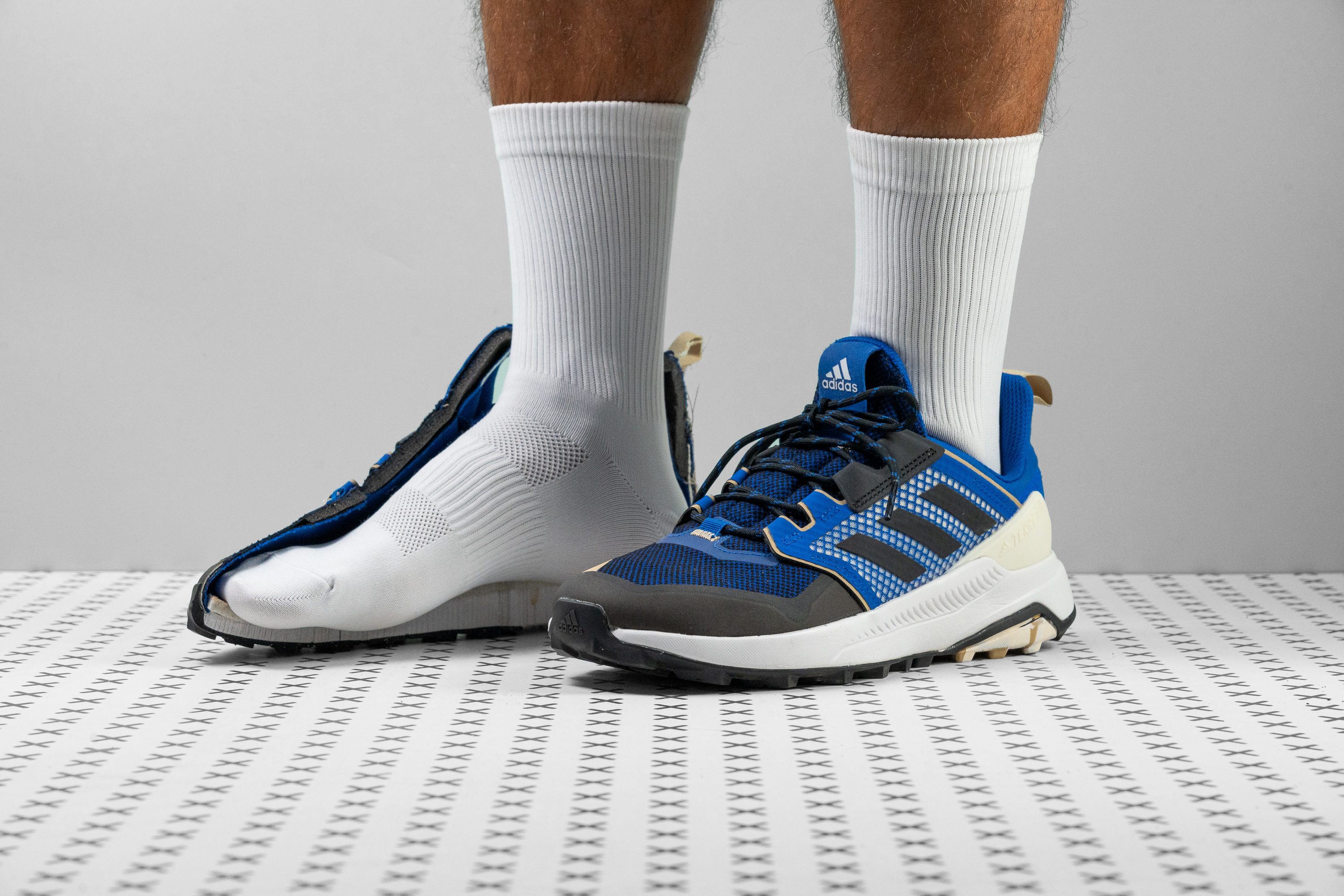












































What makes it the best?
Cheap hiking shoes can absolutely be exceptionally lightweight and impressively durable, as can be seen in the Adidas Terrex Trailmaker. They offer an incredible bang for your buck, combining a marvelously lightweight profile that won’t wear out after a few scuffs and scrapes. For this reason, we have chosen it as our best cheap, lightweight hiking shoe.
Tipping the scales at 12.7 oz (361g), these hikers are as good as it gets when it comes to cheap, lightweight hiking shoes! Weighing 1.2 oz (34g) less than average, they feel agile and freeing on our feet. We felt footloose and had plenty of energy left over at the end of a hike.
You’d be forgiven for thinking that a cheap shoe will fall apart quickly, but there is more to the Terrex Trailmaker than meets the eye. We applied a Dremel to the fabric upper for 12 seconds, at a force of 3.2N at 5K RPM. The sturdy fabric withstood quite some abuse, leaving only a small scuff, so we awarded it 3/5 for durability. On the trail, this hardy shoe takes quite some battering with little wear to show for it.
We definitely got more than we expected with the Trailmaker. With an RRP of just $110, it is $18 cheaper than the average for hiking shoes, making it excellent value for money.
We must point out that this is not the ideal shoe for backpacking. With no serious ankle support and 3 mm less cushioning underfoot, we don’t feel there is sufficient support for long days on technical trails, especially not with a heavy pack. We recommend long-distance hikers look into other options.
Pros
- Extra lightweight
- Amazing in-shoe comfort
- Highly breathable
- Balance of cushion and ground feel
- Stable for a light shoe
- More flexible than average
- Welcomes wide feet
- Secure lockdown (bootie upper)
Cons
- Outsole lacks durability
- Not enough grip on wet terrain
Best cheap hiking shoes made of sustainable materials
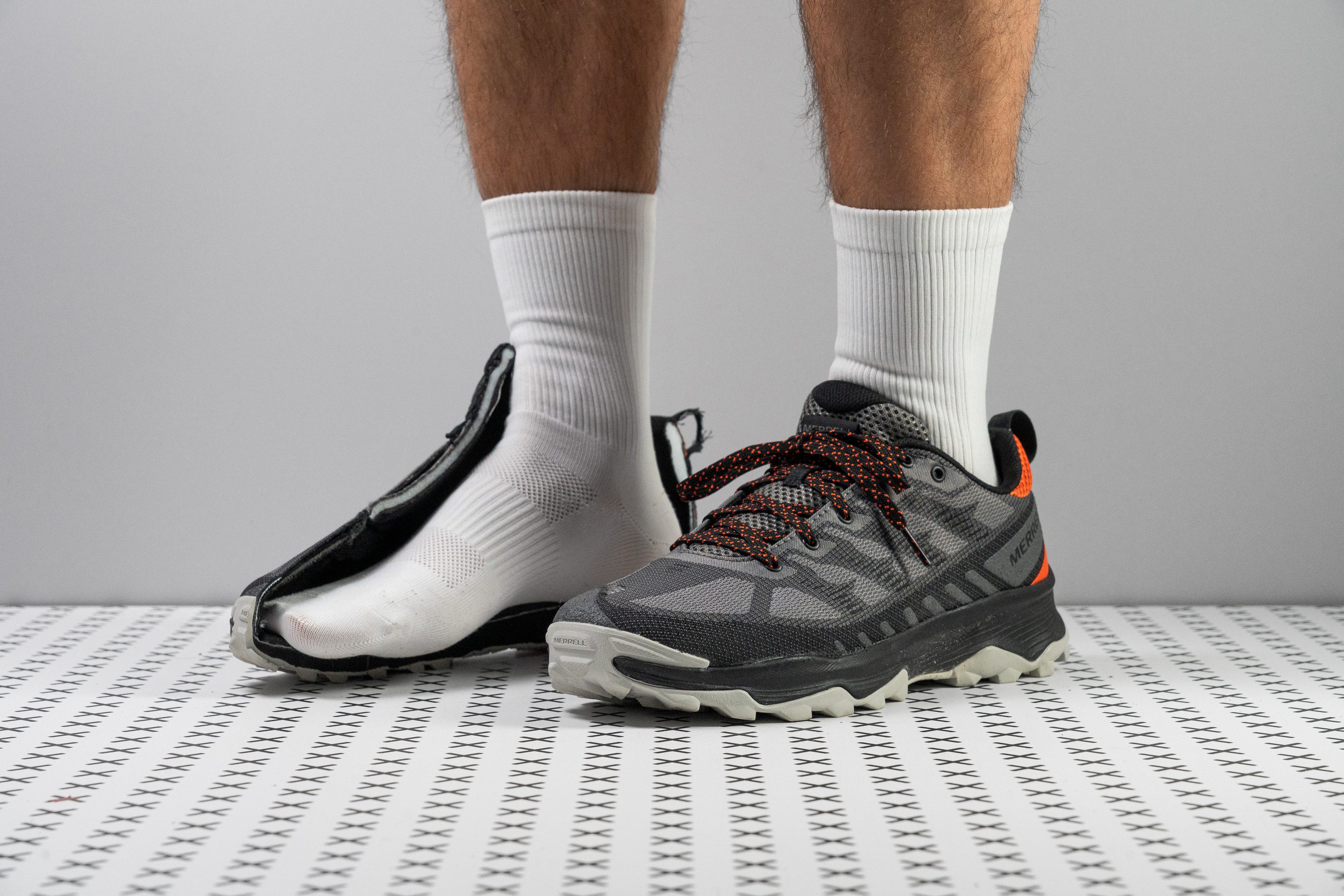













































What makes it the best?
The Merrell Speed Eco is made with intention and care by using eco-friendly materials. Surprisingly, it only costs $110, and what’s even more amazing is how it doesn’t sacrifice performance for its price point. Lab results confirm what our feet enjoyed: speed in a light and flexible shoe, making it our best sustainable, cheap hiking shoe.
Nearly every part of the Speed Eco is made from recyclable materials, from its outsole to its mesh upper and even its laces! It walks the talk and represents its name well.
We could speed hike when we wanted to, with the midsole offering a nice kick to our steps. Testing for energy return, the Speed Eco recorded an above-average 54.0%.
Comfort is enhanced through its light and malleable structure. It never burdened our feet during long hours on foot, with its 11.6 oz (329g) weight being 13.4% below average. In addition, the midsole adapts to our natural foot flexion with ease. In our bend test, it emerged 22.4% more flexible than average, proving it’s ideal for hikes.
Unfortunately, what its sustainable materials sacrificed is breathability. The upper traps heat, so we don’t recommend it in warm conditions.
Pros
- Balanced ground feel and impact protection
- Feels lively and responsive underfoot
- Firm and stable platform
- Notably lighter then average
- Highly durable upper mesh
- Affordable price point
- A ton of recycled materials
- Fits true to width
- Doesn't get any firmer in cold
Cons
- Lacks breathability
- Frail inner lining
- Outsole rubber wears easily
- Tongue is not gusseted as promised
Some hiking shoes are seductive. They come with attractive colorways, cool features, and awesome aesthetics. They draw us in, and before we know it, we imagine how they will take our hiking to the next level. But then we see the price tag.
Sound familiar? We’ve all been there. The reality is that nowadays, some footwear comes with jaw-dropping price tags. However, the good news is that some good deals are out there. You just have to know how to find them.
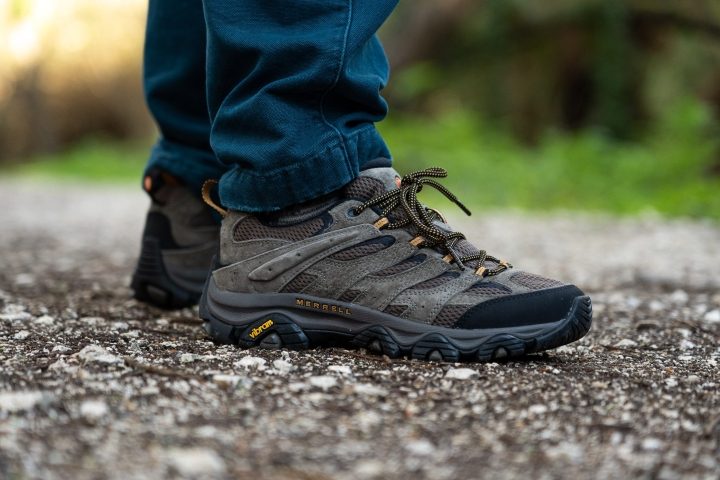
Hiking shoes don’t have to break the bank
You shouldn’t have to invest your life saving, an arm, and a leg to purchase a new pair of hiking shoes. There are plenty of cheap hiking shoes to choose from that will serve you just fine. Trust us; we’ve done the research.
Popular to contrary belief, buying a cheap pair of hiking shoes does not mean that the shoes will be bad quality. There are plenty of high-quality cheap hiking shoes on the market. So if you are an entry-level hiker or a hiker on a budget, consider the following when you start browsing for hiking shoes.
What to look for in budget hiking shoes
A trustworthy and reputable brand
Many of the industry’s most trustworthy and reputable brands manufacture budget-friendly hiking shoes. They understand that not every one of their customers is looking for top-notch performance and fancy features. Therefore, they create entry-level shoes with a lower price point.
Fantastic brands like Addidas, Keen, Columbia, Salomon, Chaco, and Merrel all produce high-quality shoes at a lower price point. By doing this, they accomplish two goals.
- They create hiking shoes that satisfy the entry-level consumer looking for a starter shoe.
- They create separation between their shoe lineup, making it easier to market new features and fundamental differences between their hiking shoes.
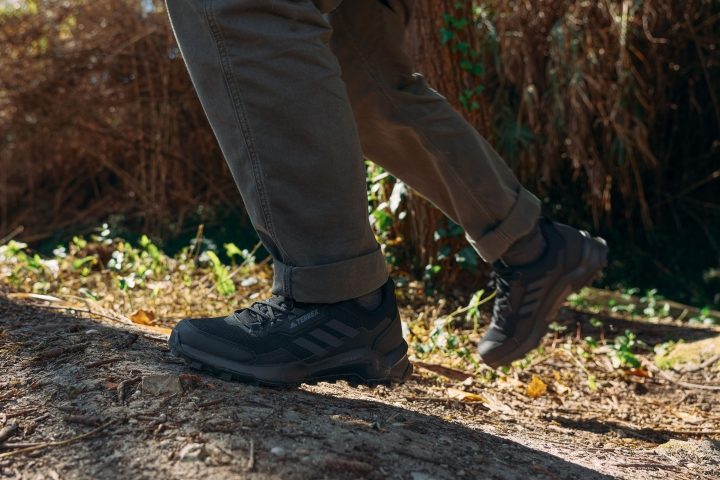
An economical outer material
There are many different types of materials used in the construction of a hiking shoe’s upper.
- Full-grain leather
- Nubuck leather
- Synthetic materials such as mesh, nylon, textiles, and vegan leather
Some are cheaper than others. To find a good pair of cheap hiking shoes, it’s best to avoid leather. Typically, full-grain leather is more expensive than Nubuck leather. Instead, to save money, prioritize synthetic materials.
The shoes included in this article all utilize synthetic materials in the upper. This helps keep the cost down. For example, the Merrel Moab 3 combines mesh and synthetic leather in the upper, while the Adidas Terrex AX4 relies heavily on mesh and nylon materials.
High-quality yet affordable midsoles
The midsole of the hiking shoe is responsible for providing cushioning and support. It's the part of the shoe that cradles your feet. To do that, hiking shoe midsoles are typically made with foam. There are two types of foam used for midsoles- polyurethane (PU) and ethylene-vinyl acetate (EVA) foam.
PU foam is denser, therefore, more rigid and expensive. EVA foam is light and, therefore, cheaper. Despite their different price points, they both serve vital functions in the midsole.
Typically hiking shoes that utilize a predominately EVA foam midsole will cost less. For example, every shoe in this article sports an EVA midsole.
If you are looking for more support, you may not need to invest in more expensive hiking shoes. Instead, it could be as simple as investing in a new insole insert. Typically this solution is much more affordable than looking for a hiking shoe with built EVA foam arch support or an inserted nylon shank.
Outsoles with good traction
The outsoles of the hiking shoe are the bottom of the shoe– the part that comes into contact with the ground every time you make a step. Outsoles are responsible for providing traction and grip and insulating your feet from the wet and cold.
For entry-level and budget-friendly hiking shoes, the ideal outsole utilizes an all-terrain or all-purpose lug profile or tread pattern. Any shoe with a more specialized lug profile for specific types of terrain or highly technical terrain costs more money.
When it comes to rubber manufacturers for outsoles, Vibram is the best in the business. Luckily, Vibram outsoles are not only included on high-end models. Many of the cheaper models of hiking shoes utilize Vibram rubber outsoles, the Merrell Moab 3 for example.
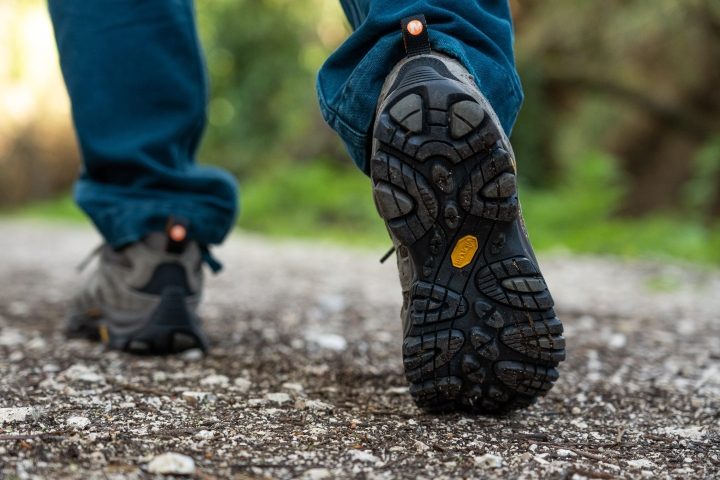
Waterproofing to keep your feet dry
Waterproofing makes hiking shoes more expensive. This is true because to make a waterproof shoe, there needs to be an additional waterproof membrane inserted into the interior of the shoe. The extra materials and labor increase the shoe’s value.
To avoid the extra cost of waterproofing, you can invest in water-resistant or water-repellent shoes instead.
If you must have a waterproof hiking shoe but still want to save money, you can try a hiking shoe without Gore-tex waterproofing. Gore-tex fabrics are the gold standard for waterproof hiking shoes. Therefore, any shoe with Gore-tex, abbreviated GTX, will be more expensive.
Luckily, many shoe manufacturers will have a non-Gore-tex waterproof model. This typically means that instead of using Gore-tex in the waterproof membrane, they’ve used some other waterproof fabric, typically an in-house proprietary fabric which is cheaper.

Warmth and insulation to keep your feet warm
The warmth created from additional insulation on the interior of the hiking shoe can be helpful if you plan to spend a lot of time in cold and wet conditions. However, it may not be necessary, especially if you live in an area with mild winters. Therefore, if you can avoid hiking shoes with insulation, you will save extra money.
The hiking shoes in this article are all considered three-season shoes, meaning they do not include any additional insulation. This keeps their cost down but makes them far from the best option during the fourth season – winter.
Red flags for cheap hiking shoes
If you keep an eye out for the components we listed above, you should be able to pick out a pair of hiking shoes that will suit your needs and stay within your budget.
However, throughout that process, you might run into some red flags. Red flags indicate that the hiking shoe you are interested in may not be worth your time. Classic red flags include deals that seem too good to be true, bad consumer reviews, and mystery brands.
We recommend diving into the reviews to avoid buying a lemon pair of hiking shoes. It’s essential to see what other people are saying about the shoes you want to buy. Reviews from “ordinary” people that include photos are the most helpful.
Remember, spokespeople or sponsors sometimes endorse hiking shoes. Unfortunately, when this happens, only the positives of the shoes are shared publicly. So take these sponsored reviews with a grain of salt and try to compare them against other reviews from ordinary people.
We strive to provide objective facts about each cheap hiking shoe in our lab.
Lastly, avoid mystery brands, even if the shoes they sell look great and are the perfect price. The brand name was the first component of a reliable yet cheap hiking shoe that we discussed above. And for a good reason. Stick to tried and trusted brands, and you’ll have more success.
How to find cheap hiking shoes
Buying cheap boots is about more than just knowing what to look for. Knowing where and when to look is also essential. So before you purchase a new pair of hiking shoes, here are some helpful tips to consider.
To save you time, RunRepeat gathers information about all discounts from over 200 retailers in one place.
Shop around in multiple places
Buying hiking shoes online is easier than ever before. Nowadays, you can easily save item listings, open new tabs, and compare hiking shoes before buying. But we understand that this process can also be overwhelming.
Look for seasonal sales and holidays
The calendar year is chock-full of seasonal sales. In the United States, Memorial day, Black Friday, Cyber Monday, and many other seasonal holidays are perfect times to look for cheap hiking shoes.
Department stores and eCommerce websites will participate in traditional seasonal sales. So if you are in between boots, we recommend being patient and waiting for a sale to start.
Purchase last season’s hiking shoes
If you don’t have the budget for them, don’t give into the hype about all the bells and whistles of modern hiking shoes. If you stick to buying last season’s models, you can save a lot of money.
You might miss out on new features by buying last season's boots. But often, the differences are almost nonexistent. We like to think hiking shoe manufacturers are constantly updating their shoes. Still, the new model sometimes only sports a different colorway, and the rest of the shoe is essentially the same.
Buy secondhand shoes
Buying used hiking shoes is another great way to find great deals. Yes, you run the risk of buying an older pair of shoes, but many times, shoes get returned for almost no reason at all. Some of the best shoes we’ve purchased have been returned due to improper sizing or minor, aesthetic defects.
Some larger retailers will have used gear sales, for example, the REI Garage Sale. You can search in person, but don’t forget to check places like online forums for hiking shoes.
Head to the bargain bin
Most gear shops and outlet stores have a bargain bin or discount section. If you look carefully and with some luck, you can find high-quality hiking shoes for bargain prices. There are a lot of online deals also.
Just be ready to be patient. Bargain shopping can take time because the selection can be limited. Therefore, it’s best to go bargain hunting without any pressure. For example, when you’re happy with your current hiking shoes but want to plan for when your current shoes inevitably break down.
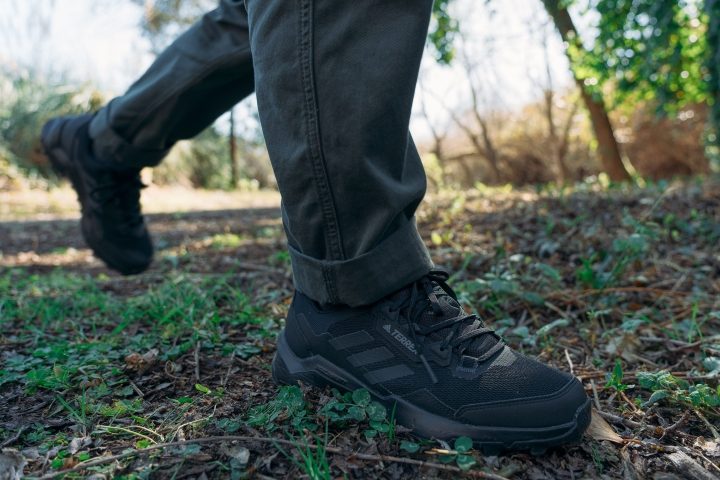
How to make your cheap hiking shoes last longer
Cheap hiking shoes don’t just disintegrate over time because they cost less. You can get your cheap hiking shoes to last just as long as more expensive ones, if not longer if you take the time to care for them.
Maintain your hiking shoes
You can lengthen the lifespan of your hiking shoes with simple, routine maintenance. For example, cleaning them after muddy or dirty days will help preserve the outer material.
Wear them only for hiking
The outsoles of hiking shoes are designed to be used on dirt trails and over mixed terrain. If you wear them on concrete, you may wear them out faster. So instead, wear your hiking shoes only when you plan to go hiking and use a different pair of shoes for running errands around town.
Focus on your footwork
Many durability issues with hiking shoes, like abrasion, holes in the upper, shredded laces, and delamination, come from poor footwork. The more time you can hike under control and avoid any unnecessary stubbed toes and collisions will preserve your shoe’s exterior and therefore lengthen its lifespan.
Store your hiking shoes properly
Another good way to make your hiking shoes last longer is to store them properly. For example, if you come home with wet feet, set them out to dry in a well-ventilated area and stuff them with newspaper. Consider setting them in front of a fan. And never use a heat source to dry your shoes.
In general, try to avoid keeping your shoes in places that experience temperature fluctuations, like car trunks and attics. Heating and cooling can cause your shoes to delaminate. Instead, keep your shoes in an area with an average room temperature.
Frequently asked questions
Why are some hiking shoes cheaper than others?
Some hiking shoes are cheaper than others because of the materials used in their construction and the lack of waterproofing and insulation. More expensive materials, such as leather, Gore-tex membranes, and additional insulation inside the shoe, will all raise the price.
Do cheap hiking shoes break quickly?
It’s common to assume that cheaper hiking shoes will break or wear down more easily than shoes that cost more money. However, that may not be true because the lifespan of the shoe is largely dependent on the user, the typical type of terrain they find themselves in, and maintenance.
For example, a person who purchased cheaper hiking shoes may get them to last longer because they maintain their shoes more and hike on easier trails than someone who spent more money but never takes care of their shoes.
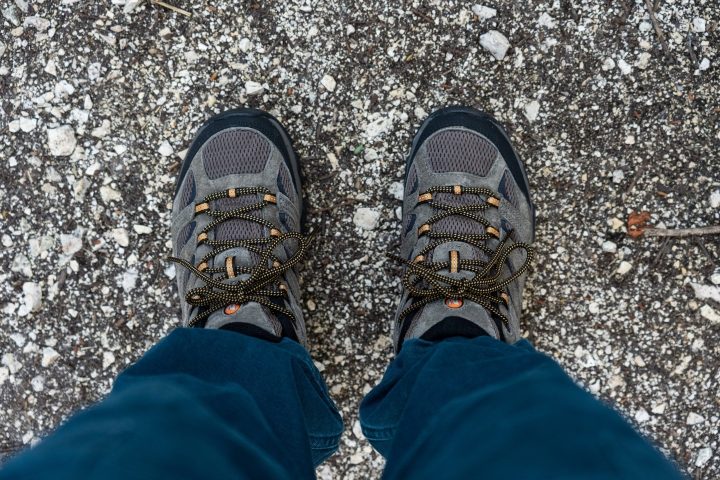
Who makes the best budget hiking shoes?
The best budget hiking shoes typically come from trustworthy brands. We consider the four brands included in this article – Chaco, Salomon, Merrel, and Adidas– to be reliable sources of high-quality footwear, despite the lower price points of the shoes we reviewed.

